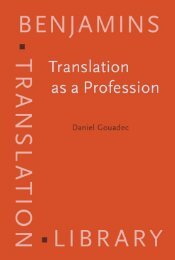Constructing a Sociology of Translation.pdf
Constructing a Sociology of Translation.pdf
Constructing a Sociology of Translation.pdf
- No tags were found...
Create successful ePaper yourself
Turn your PDF publications into a flip-book with our unique Google optimized e-Paper software.
58 Theo Hermansenty Greek translators <strong>of</strong> the Hebrew Bible in Alexandria who all worked independently<strong>of</strong> each other yet produced identical renderings. God had apparentlybreathed the one correct version into the translators’ ears, hence the remarkableresult. The story <strong>of</strong> the miracle evidently serves the purpose <strong>of</strong> investing the Greekrendition with a status equal to that <strong>of</strong> the Hebrew original. For Saint Augustine,God spoke with the same intent and with equal authority in both versions.Perhaps not everyone who has read around in more recent translation historyhas come across the story <strong>of</strong> the Book <strong>of</strong> Mormon, very similar to that <strong>of</strong>the Septuagint but even more spectacular. The detail <strong>of</strong> how in the 1820s JosephSmith managed to translate an unknown script from a collection <strong>of</strong> gold plateswhich he had dug up following the directions <strong>of</strong> the angel Moroni, would taketoo long here (see Hill 1977; Persuitte 1985; Robinson 2001: 54–61). The definingmoment <strong>of</strong> this intriguing tale occurred when, in July 1829, the translation wasready and Joseph Smith’s associates were allowed to see and touch the mysteriousgold plates as the assembled company witnessed another visitation from Moroni.During these proceedings a voice descending from heaven declared that “thebook is true and the translation accurate”, whereupon the angel took the originalplates under his wing and vanished with them, for good. They have not beenseen since. The physical removal <strong>of</strong> the original emphatically sealed the divinepronouncement, the proclamation from on high which endowed the translationwith a value equal to that <strong>of</strong> the original. The pronouncement, that is, madetranslation and original equivalent. In so doing it enabled the translation to displacethe original, which indeed was no longer needed and could be taken awaywithout loss.If not everyone interested in the recent and current history <strong>of</strong> translationknows about the Convention <strong>of</strong> Vienna, this is unfortunate, because in one wayor another it affects every country on the globe, and therefore every one <strong>of</strong> usas citizens. The United Nations’ Vienna Convention on the Law <strong>of</strong> Treaties, firstadopted in 1969, governs international treaties. Such treaties normally exist inthe form <strong>of</strong> parallel texts in several languages. If some <strong>of</strong> these versions havecome into existence as translations, they cease to be translations as soon as themultilingual treaty is agreed by the relevant parties as constituting one singlelegal instrument. “Agreeing” here means that the parallel texts <strong>of</strong> the treaty areauthenticated, that is, recognized as equivalent sources for the interpretation <strong>of</strong>the treaty. From that moment onwards the translations become versions whichall possess equal value in law and are, on that basis, presumed to have the samemeaning. Indeed paragraph 3 <strong>of</strong> article 33 <strong>of</strong> the Vienna Convention states that“The terms <strong>of</strong> a treaty are presumed to have the same meaning in each authentictext” (Reuter 1995: 261). All the key documents <strong>of</strong> the European Union, forinstance, are in this sense equal, equivalent and definitive versions in all <strong>of</strong> the
















